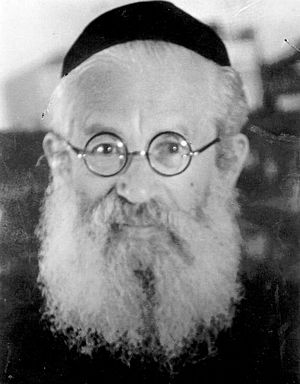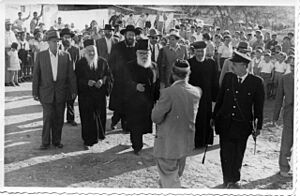Yitzhak HaLevi Herzog facts for kids
Quick facts for kids Yitzhak HaLevi Herzog |
|
|---|---|
 |
|
| Religion | Judaism |
| Personal | |
| Nationality | Irish, Israeli |
| Born | 3 December 1888 Łomża, Congress Poland |
| Died | 25 July 1959 (aged 70) Jerusalem |
| Senior posting | |
| Title | Ashkenazi Chief Rabbi of Israel |
| Successor | Isser Yehuda Unterman |
| Began | 1948 |
| Ended | 1959 |
| Other | Chief Rabbi of Ireland (1919–1936) Ashkenazi Chief Rabbi of the British Mandate of Palestine (1936–1948) |
| Buried | Sanhedria Cemetery, Jerusalem, Israel |

Yitzhak HaLevi Herzog (Hebrew: יצחק אייזיק הלוי הרצוג; born December 3, 1888 – died July 25, 1959) was a very important Jewish leader. He was also known as Isaac Herzog. He served as the first Chief Rabbi of Ireland from 1921 to 1936. After that, he became the Ashkenazi Chief Rabbi for the Jewish community in Palestine. When Israel became an independent country in 1948, he continued as its Chief Rabbi until he passed away in 1959.
Contents
Early Life and Education
Isaac Halevi Herzog was born in Łomża, Poland. His parents were Liba Miriam (Cyrowicz) and Joel Leib Herzog. In 1898, his family moved to the United Kingdom and settled in Leeds. His father, who was a rabbi, taught him a lot when he was young. Later, his father became a rabbi in Paris.
Yitzhak was very good at studying the Talmud (a central text of Jewish law and tradition) from a young age. He then went to the Sorbonne and the University of London. There, he earned his doctorate degree. His special research project made him famous in the Jewish world. He claimed to have found the secret to making Tekhelet again. This was a special blue dye used long ago for Tzitzit (fringes on Jewish prayer shawls).
Rabbi Herzog's family has continued to be important in Israel's government. His son, Chaim Herzog, was a general in the Israel Defense Forces. He later became Israel's ambassador to the UN and then the President of Israel. Another son, Yaakov Herzog, was Israel's ambassador to Canada. He also worked as the Director General of the Prime Minister's Office. Rabbi Herzog's grandson, Isaac Herzog, is also a well-known politician. He has been a member of the Knesset (Israel's parliament) and served as a government minister.
A Leader for His People
Rabbi Herzog worked as a rabbi in Belfast from 1916 to 1919. In 1919, he became the rabbi of Dublin. He could speak the Irish language very well. He supported the First Dáil (Ireland's first parliament) and the Irish independence movement. Because of this, he was sometimes called "the Sinn Féin Rabbi."
He served as the Chief Rabbi of Ireland from 1922 to 1936. Then, he moved to Palestine to become the Ashkenazi Chief Rabbi. He took over after Rabbi Abraham Isaac Kook passed away. He supported both the Irish Republican Army and the Irgun (a Jewish underground group in Palestine).
In May 1939, before World War II, the British government released the White Paper of 1939. This document limited Jewish immigration to Palestine. Rabbi Herzog led a large march through Jerusalem. Jewish people from all groups joined together, which was unusual. On the steps of the Hurva Synagogue, he dramatically tore the White Paper in half. He said, "We cannot agree to the White Paper. Just as the prophets did before me, I hereby rip it in two." Many years later, in 1975, his son, Ambassador Herzog, did a similar action at the UN. He tore a UN resolution that said Zionism was like racism.
During World War II, Rabbi Herzog bravely traveled to the United States. He managed to meet with President Roosevelt. He pleaded for help for the Jewish people in Europe. His biographer wrote that his hair turned white after the meeting. He felt it was a failure because he didn't get a promise of help. He quickly returned home, narrowly missing a ship that was sunk by a German submarine. He took what was said to be the last civilian ship to cross the Atlantic during the war.
After the war, Rabbi Herzog worked hard to save Jewish children. Many of these children had been hidden in Christian monasteries or by Christian families across Europe. He tried to bring them back to their families or to Jewish orphanages. Sometimes, it was difficult to get the children back. His biography tells about his efforts to meet the Pope, who avoided him. However, he eventually received help from the Vatican. Later, it was discovered that Karol Wojtyła, who would become Pope John Paul II, helped Rabbi Herzog. Some people who defend Pope Pius XII say that Rabbi Herzog had good relations with the Pope during and after the war. In 1945, Rabbi Herzog said that Jewish people would never forget what the Pope and his helpers did for them during a very difficult time.
Books and Writings
Rabbi Herzog was known as a great expert in Jewish law. He wrote many books and articles. These writings discussed Jewish law (called halacha) and how it related to the new State of Israel. His works helped shape the ideas of the Religious Zionist Movement about Israel.
Some of Rabbi Herzog's books include:
- Main Institutions of Jewish Law
- Heichal Yitzchak
- Techukah leYisrael al pi haTorah
- Pesachim uKetavim
- The Royal Purple and the Biblical Blue
Special Awards
- In 1958, Rabbi Herzog received the Israel Prize. This is a very important award in Israel, and he won it for his writings on rabbinical literature.
See also
 In Spanish: Yitzhak HaLevi Herzog para niños
In Spanish: Yitzhak HaLevi Herzog para niños

